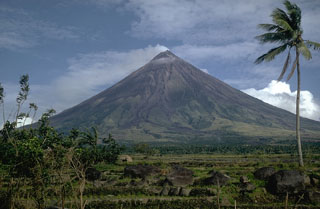Report on Mayon (Philippines) — 20 December-26 December 2023
Smithsonian Institution / US Geological Survey
Weekly Volcanic Activity Report, 20 December-26 December 2023
Managing Editor: Sally Sennert.
Please cite this report as:
Global Volcanism Program, 2023. Report on Mayon (Philippines) (Sennert, S, ed.). Weekly Volcanic Activity Report, 20 December-26 December 2023. Smithsonian Institution and US Geological Survey.
Mayon
Philippines
13.257°N, 123.685°E; summit elev. 2462 m
All times are local (unless otherwise noted)
PHIVOLCS characterized activity at Mayon as “decreased unrest” during 19-26 December. The seismic network recorded 0-6 daily volcanic earthquakes and a total of two rockfall events during 21-24 December. Emissions were visible daily, rising as high as 500 m above the summit and drifting NW, W, and SW. The Tokyo VAAC reported that at 0852 on 23 December an ash emission was identified in a satellite image rising to 2.4 km (8,000 ft) a.s.l. and drifting WSW based on satellite data and information from PHIVOLCS. The Alert Level remained at 2 (on a 0-5 scale). Residents were reminded to stay away from the 6-km-radius Permanent Danger Zone (PDZ) and pilots were advised to avoid flying close to the summit.
Geological Summary. Symmetrical Mayon, which rises above the Albay Gulf NW of Legazpi City, is the most active volcano of the Philippines. The steep upper slopes are capped by a small summit crater. Recorded eruptions since 1616 CE range from Strombolian to basaltic Plinian, with cyclical activity beginning with basaltic eruptions, followed by longer periods of andesitic lava flows. Eruptions occur predominately from the central conduit and have also produced lava flows that travel far down the flanks. Pyroclastic density currents and mudflows have commonly swept down many of the approximately 40 ravines that radiate from the summit and have often damaged populated lowland areas. A violent eruption in 1814 killed more than 1,200 people and devastated several towns.
Sources: Philippine Institute of Volcanology and Seismology (PHIVOLCS), Tokyo Volcanic Ash Advisory Center (VAAC)

